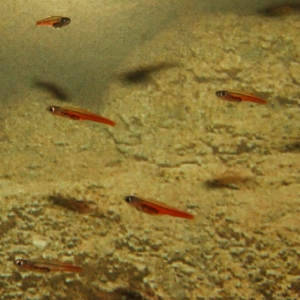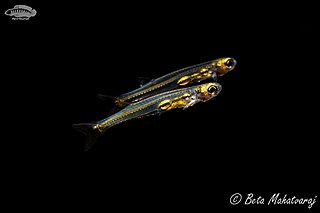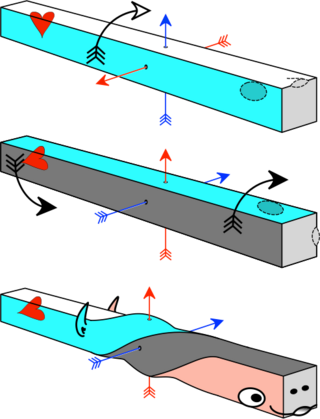
The zebrafish is a freshwater fish belonging to the minnow family (Cyprinidae) of the order Cypriniformes. Native to India and South Asia, it is a popular aquarium fish, frequently sold under the trade name zebra danio. It is also found in private ponds.

The central nervous system (CNS) is the part of the nervous system consisting of the brain and spinal cord, the retina and optic nerve, and the olfactory nerve and epithelia. The CNS is so named because the brain integrates the received information and coordinates and influences the activity of all parts of the bodies of bilaterally symmetric and triploblastic animals—that is, all multicellular animals except sponges and diploblasts. It is a structure composed of nervous tissue positioned along the rostral to caudal axis of the body and may have an enlarged section at the rostral end which is a brain. Only arthropods, cephalopods and vertebrates have a true brain, though precursor structures exist in onychophorans, gastropods and lancelets.

Cyprinidae is a family of freshwater fish commonly called the carp or minnow family, including the carps, the true minnows, and their relatives the barbs and barbels, among others. Cyprinidae is the largest and most diverse fish family, and the largest vertebrate animal family overall, with about 3,000 species; only 1,270 of these remain extant, divided into about 200 valid genera. Cyprinids range from about 12 mm (0.5 in) in size to the 3 m (9.8 ft) giant barb. By genus and species count, the family makes up more than two-thirds of the ostariophysian order Cypriniformes. The family name is derived from the Greek word kyprînos.

The GloFish is a patented and trademarked brand of fluorescently colored genetically modified aquarium fish. They have been created from several different species of fish: zebrafish were the first GloFish available in pet stores, and recently the skirt tetra, tiger barbs, Rainbow Shark, Siamese fighting fish, and most recently Bronze corydoras have been added to the lineup. They are sold in many colors, trademarked as "Starfire Red", "Moonrise Pink", "Sunburst Orange", "Electric Green", "Cosmic Blue", and "Galactic Purple", although not all species are available in all colors. Although not originally developed for the ornamental fish trade, it is one of the first genetically modified animals to become publicly available. The rights to GloFish are owned by Spectrum Brands, Inc., which purchased GloFish from Yorktown Technologies, the original developer of GloFish, in May 2017.

The cerebrum, telencephalon or endbrain is the largest part of the brain containing the cerebral cortex, as well as several subcortical structures, including the hippocampus, basal ganglia, and olfactory bulb. In the human brain, the cerebrum is the uppermost region of the central nervous system. The cerebrum develops prenatally from the forebrain (prosencephalon). In mammals, the dorsal telencephalon, or pallium, develops into the cerebral cortex, and the ventral telencephalon, or subpallium, becomes the basal ganglia. The cerebrum is also divided into approximately symmetric left and right cerebral hemispheres.

In neuroanatomy, the superior colliculus is a structure lying on the roof of the mammalian midbrain. In non-mammalian vertebrates, the homologous structure is known as the optic tectum or optic lobe. The adjective form tectal is commonly used for both structures.
The black-barred danio is a species of Danio discovered in Myanmar by Tin Win in 2005 and described in 2015 by Sven Oscar Kullander and Ralf Britz.

Danionella is a genus of danionin fish found in freshwater habitats in Myanmar and West Bengal, India. It includes some of the smallest fishes.

Danionella translucida is an extremely small species of cyprinid fish endemic to Myanmar. When described, it was considered to be one of the smallest fish. It was collected from the roots of floating aquatic plants in a slow-flowing, shallow stream in the Pegu Division of Myanmar. It was found alongside Danio, Microrasbora, Erethistes, and Oryzias species. Observed in life, D. translucida is almost perfectly transparent except for its eyes. It has a distinctive pattern of melanophores. There are no melanophores on the dorsal surface except on the head over the posterior part of the brain. On the posterior half of the body, there a few melanophores following the horizontal midline. The sides and underside of the abdomen have melanophores. A double row of melanophores is present on the underside of the fish from the isthmus of the gills to the pelvic fins. Eggs in D. translucida has been found to range in size from about 0.3–0.6 mm (0.012–0.024 in) in diameter, with ripe eggs being at least 0.5 mm (0.020 in) in diameter. Females carried anywhere from 3 to 8 or 10 eggs. Compared to the body of the fish, these eggs are relatively large.
GnRH2, also known as gonadotropin-releasing hormone II or LHRH-II. Its gene is located on human chromosome 20.

Paedocypris is a genus of tiny cyprinid fish found in swamps and streams on the Southeast Asian islands of Borneo, Sumatra and Bintan.
The dracula fish is a species of tropical danionin fish from the cyprinid family. It is a freshwater fish endemic to Myanmar. A close relative is Danio rerio, the zebrafish of aquariums. It is named dracula after its unusual "fangs"; male dracula fish have protruding tooth-like bones stemming from their jawbones. Males have been observed using their fangs to spar with other males.

Teleost leptins are a family of peptide hormones found in fish (teleostei) that are orthologs of the mammalian hormone leptin. The teleost and mammalian leptins appear to have similar functions, namely, regulation of energy intake and expenditure.

The danionins are a group of small, minnow-type fish belonging to the family Cyprinidae. Species of this group are in the genera clades danio and devario, based on the latest phylo-genetic research by Fang et al in 2009. They are primarily native to the fresh waters of South and Southeast Asia, with fewer species in Africa. Many species are brightly coloured and are available as aquarium fish worldwide. Fishes of the danio clade tend to have horizontal stripes, rows of spots, or vertical bars, and often have long barbels. Species within the devario clade tend to have vertical or horizontal bars, and short, rudimentary barbels, if present at all. All danionins are egg scatterers, and breed in the rainy season in the wild. They are carnivores, living on insects and small crustaceans.

Danionella priapus is a species of Danionella endemic to India. It is sexually dimorphic and, like other species in the genus, possesses a skeleton with fewer bones than the closely related zebrafish. However, it has a number of distinguishing features which differentiate it from others in the genus, with the most notable example being the conically projecting genital papilla between the funnel-shaped pelvic fins of males.

The axial twist theory is a scientific theory put forward to explain a range of unusual aspects of the body plan of vertebrates. It proposes that the rostral part of the head is "turned around" regarding the rest of the body. This end-part consists of the face as well as part of the brain. According to the theory, the vertebrate body has a left-handed chirality.

Pelvic fins or ventral fins are paired fins located on the ventral (belly) surface of fish, and are the lower of the only two sets of paired fins. The pelvic fins are homologous to the hindlimbs of tetrapods, which evolved from lobe-finned fish during the Middle Devonian.
The Cyp11a2 is a fish gene encoding a CYP450 monooxygenase, which was originally identified in Zebrafish, is the isozyme and paralogous of fish CYP11A1, catalyzes conversion of cholesterol to pregnenolone.
Marnie Halpern is the Andrew J. Thomson Professor and Chair of molecular and systems biology at the Geisel School of Medicine at Dartmouth College. She is a Pew Scholar in the Biomedical Sciences. and a Fellow of the American Association for the Advancement of Science.












